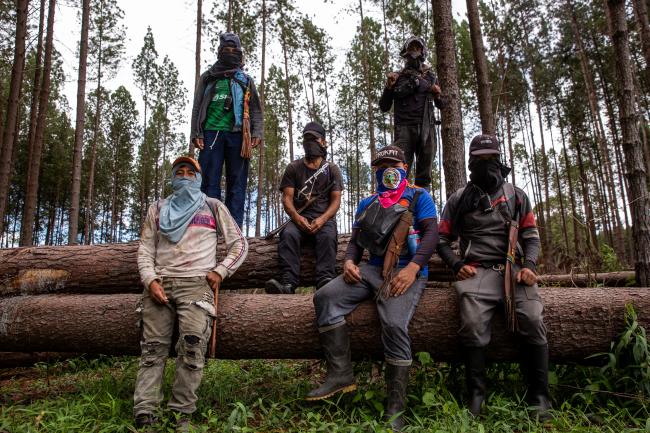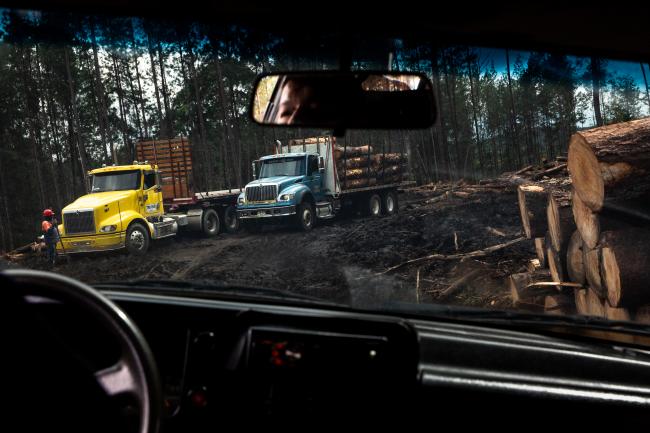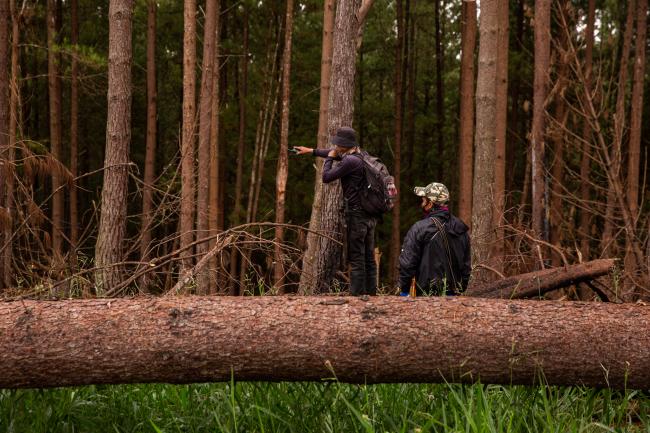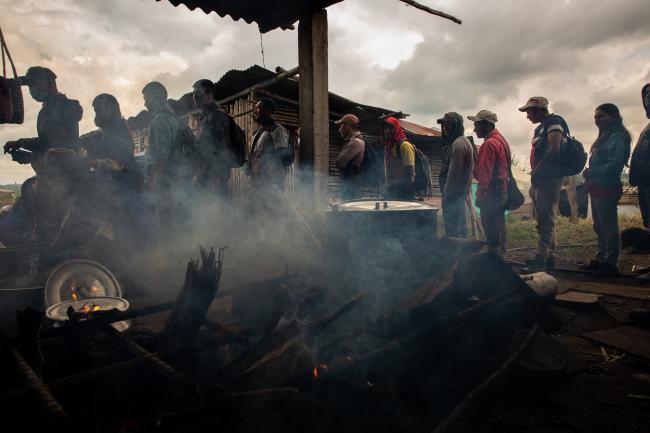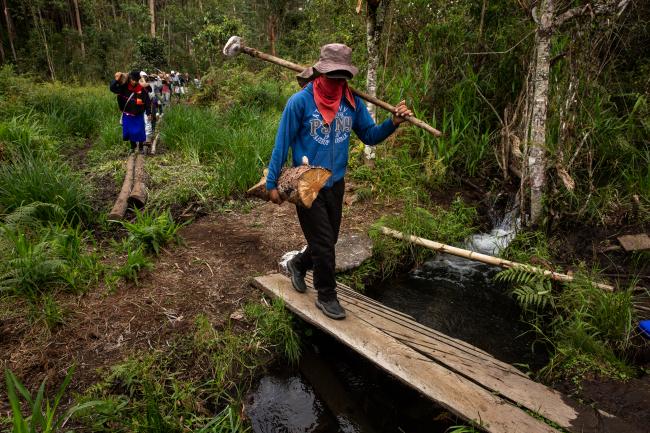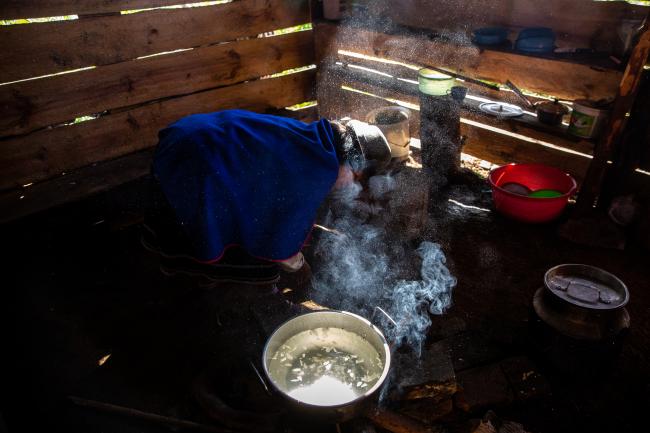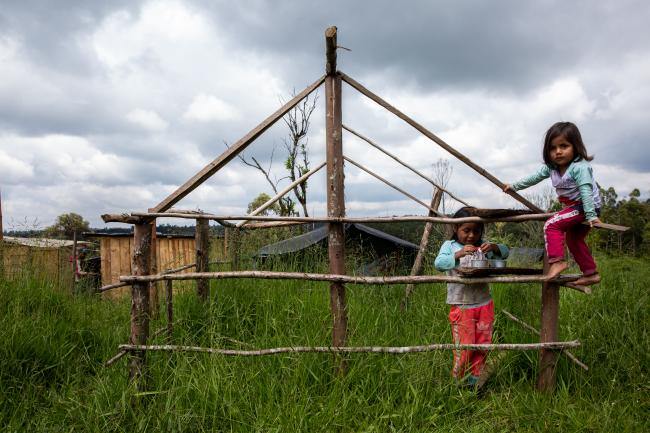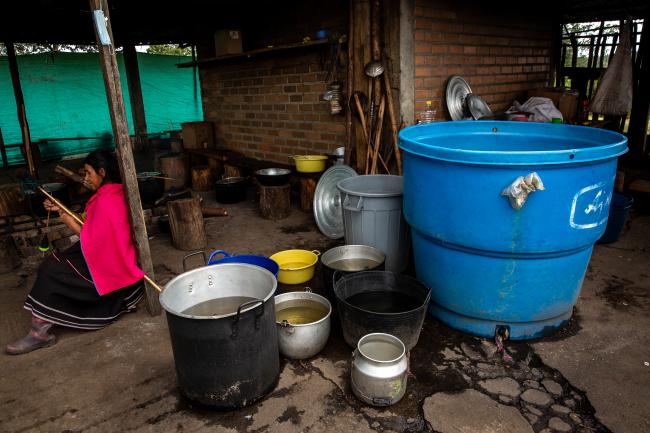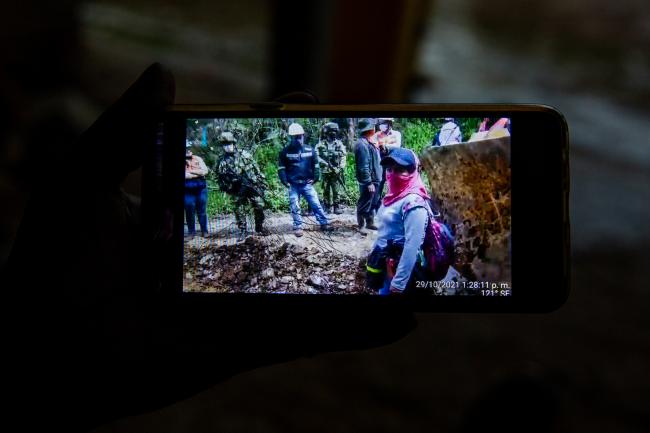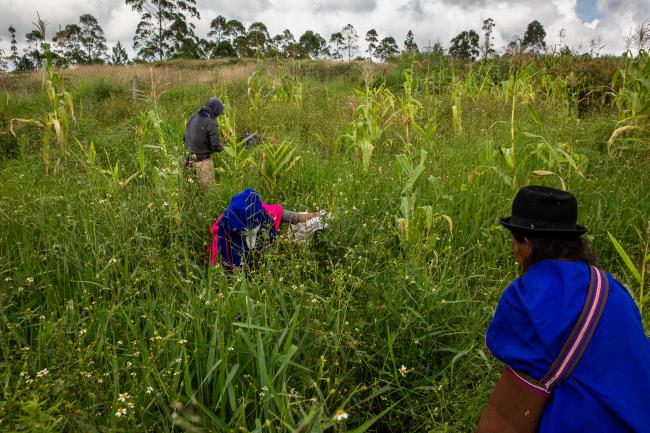Indigenous Community Confronts a Colombian Paper Giant
"They came. They had the Bible and we had the land. They told us: ‘Close your eyes and pray’, and when we opened our eyes, they had the land and we had the Bible.” This famous quote from the writer Eduardo Galeano traces the conflict over land back to the time of colonization.
The issue of land tenure in Colombia has persisted for centuries. The main victims of the years of monopolization and land dispossession practices have been Indigenous, Afro-Colombian, and peasant communities.
“A large portion of our land was stripped from us. Today the owners are large landlords like Smurfit Kappa and the sugar cane companies from Cauca and Cauca Valley,” explains Edgar Velasco, General Secretary of the Southwestern Indigenous Authorities (AISO). Sugar cane has been grown in southwestern Colombia, where the weather permits it to grow all year around, since the colonization period, when the colonizer Belalcazar violently dispossessed Indigenous people from their land to plant this product.
In addition to historical violent land grabs, Indigenous people and campesinos are victims of practices implemented by sugar and paper empires—like unfair contracts with illiterate small landowners—to obtain land for little to no money. Our ancestors “rented the land in good faith, but later on, were forced to sell it,” Velasco said.
On July 27, 2021, the Misak Indigenous community, together with campesinos from the region, occupied multinational paper giant Smurfit Kappa’s pine and eucalyptus plantations in Cauca, Colombia. While both of these groups demand just access to the land, to the Misak people, this land is essential to reclaiming their history and culture.
During the occupation, the communities denounced land-grabbings carried out by Smurfit Kappa, the environmental damage caused by the plantations, and the government’s failure to distribute land in compliance with the 2016 peace treaty.
Meanwhile, state and company workers have violently attacked multiple campesinos and Indigenous people. According to reports by the Jose Marti Human Rights Collective, one man was killed, one man was unlawfully arrested by the National Army, and 20 people were injured, one of whom lost their hand due to a stun grenade explosion.
Residents have also denounced the intentional damage of a public road and the water system by company workers, actions that violate the community’s human rights. Smurfit Kappa has refused to respond to a request for an interview.
During the occupation, campesinos and Indigenous people joined forces and set up a camp building made of wood and plastic on the edge of the plantations. So far, they have cut down or damaged around 1,000 hectares of pine and eucalyptus. The Colombian government responded by deploying the National Army, the Mobile Anti-Disturbance Squadron (ESMAD), and the police force during the interventions. Activists have reported the indiscriminate use of stun grenades, tear gas, and even live ammunition.
Smurfit Kappa in Colombia: Environmental and Labor Scandals
The Irish multinational company operates in 35 countries. According to its CEO Tony Smurfit, Colombia is one of its six most important sites. Its forest division is located in 33 municipalities of the departments of Cauca, Cauca Valley, Caldas, Quindio, Risaraldas and Tolima. It has a total of 70,000 hectares in the country, of which approximately 20,000 are in Cauca.
Smurfit Kappa arrived in Colombia in 1986 through the acquisition of the Container Corporation of America, the main shareholder of Carton de Colombia. Since then, the company has been criticized multiple times for its environmental practices and working conditions. Actions such as arbitrarily dismissing employees, pressuring sick workers to resign, and persecuting unionists have also raised questions regarding the company’s ethical standards.
The company’s environmental practices in Colombia are also concerning. In 1959, Smurfitt Kappa received a concession from the National Institute of Renewable Natural Resources and Environment (INDERENA). Until 1993, Carton de Colombia, in complicity with the Colombian government, deforested over 60,000 tropical rainforests in Bajo Calima, in the Pacific region of the Cauca Valley. The vice-president of Carton de Colombia proclaimed that they were “the first company in the world to produce wood pulp made of tropical hardwoods.'' According to the World Wildlife Fund, the deforestation of tropical rainforests is a particular concern, as they are home to most biodiversity in the world.
Smurfitt Kappa deforested large portions of tropical forest through clearcutting practices (as opposed to selective cutting) in Bajo Calima and generated a scandal. In response, the multinational renounced its rights for exploitation in the area. However, according to declarations made by human rights organizations during the People’s Permanent Tribunal Biodiversity Hearing, the company continued secretly purchasing tropical wood from local communities in Bajo Calima.
Reclaiming Territory to Reclaim Everything
The Misak people have struggled for generations against repeated dispossession from colonizers, large landowners, and multinationals.
“Our grandparents used to tell us how we were displaced to the mountains. In the old times, our people did not have an education, nor did they know how to read. This is how they dispossessed us of our land,” explains Taita (ex-leader) Jose Tunubala, who asked not to use his real name for his safety.
For decades, the communities were stripped of their land through misleading ownership deeds. Later on, they worked as terrajeros, or tenant farmers, on the land that was taken away from them. These lands were illegally acquired; the process violated the non-transferable rights of Indigenous collective land.
“My grandfather died at the age of 90 years old as a terrajero. He used to tell my father how in those times people were like slaves. They forced them to carry heavy things and treated them very badly, like animals,” said Tunubala.
Floresmiro Calambas, who is now in charge of the laboratory of the Traditional Medicine Center in the Payan House, recounts the stories of his mother from that time. She used to tell him how she would work for 12 hours a day in the farms, chewing coca leaves to suppress hunger.
Such exploitation predominated until the 70s, when Indigenous movements to reclaim their territories and fight for their rights emerged.
“Since the 80s we have woken up,” Taita Jose says. The Misak took back many hectares of land in the 80s and 90s, leading to the creation of the Guambia Indigenous reservation. Large-scale landowners and cattle breeders were expelled and their land was redistributed to the people. Las Mercedes farm is one of the recuperated farms and now in its place are the Payan Memory House, the Traditional Medicine Center, and the Misak University. This shift in the use of the territory connects land restitution with the reconstruction of Indigenous tradition and culture.
Nowadays, under the slogan “reclaiming the territory to reclaim everything,” the Misak community continues to fight for their right to their ancestors’ land in the Cauca region, now against Smurfit Kappa.
“The debate is not exclusively about a plot of land, the debate is about justice… Afro-Colombians, Indigenous peoples, and peasants have the right to access the land,” Velasco says
Land Within the Peace Treaty
Colombia has made headlines for the alarming number of social leaders killed this year. In January alone, Amnesty International reported that 13 human rights defenders were assassinated and 13 massacres occurred.
The decades-long armed conflict has forced thousands of campesinos and Indigenous people to abandon their land and territory. The Comptroller General of the Republic (CGR) has stated that “the acts of violence within the Colombian conflict, including forced displacement, are related functionally to socioeconomic interests.”
“Unfortunately, in our country, the government does not support the agriculture sector. For this reason, many people do not have the money to produce food. Many others had to migrate due to violence and ended up renting the land to Carton de Colombia for very little money,” explains Juan Sanchez, a peasant and land defender who asked not to use his real name for his safety.
Peasants and Indigenous communities say that big companies and multinationals, including Smurfit Kappa, have taken advantage of the conflict to expand the company —and its profits—by pushing people from their lands.
In 2017, the Land Restitution Court of Cali determined that Reforestadora Andina, a subsidiary of Smurfit Kappa in Colombia had “profited from the circumstance of violence.” Reforestadora Andina had acquired 78 hectares of land formerly owned by the Rivera family at a price set unilaterally by the company. The company acquired the property after the family was forced from their land to escape clashes between armed groups. The court ruled in favor of the Rivera family and ordered that the company restitute their property.
This, however, is an isolated case against the company, and the national prospects are not encouraging. As part of the 2016 peace treaty with the FARC, the government agreed to allocate three million hectares to the rural population most affected by the conflict and poverty, and to legalize seven million hectares, as rural land in Colombia is largely informally owned. This rural reform is considerably behind schedule. More than five years later, only 235,000 hectares have been allocated and two million legalized, according to the Comptroller Report of 2021.
In addition to the slow pace of rural reform, an investigation conducted by La Silla Vacía argues that the numbers were inflated, pointing to the fact that the National Land Agency (ANT) does not differentiate between legalization and allocation. This means that fewer families than were reported have actually acquired additional land.
Complying with the peace treaty is complicated by land monopolization in the country. According to Indepaz, about half of the land in Cauca belongs to just three percent of the population. Meanwhile, the vast majority of peasants, Indigenous, and Afro-Colombians in the region live on parcels averaging one hectare, which is far below the 4-14 hectares established as the minimum land area necessary to subsist by the Agricultural Household Unit (UAF).
Although the Misak community previously regained around 2,000 hectares of land, the space is not enough for the more than 21,000 community members to live.
The Misak reservation is currently 18,000 hectares, but not all the land is productive. Many are considered protected areas and the community guards them based on its cosmovision as sons and daughters of the water, born from the moorlands.
Despite the many challenges, the Misak people are determined to continue fighting. “They will not be able to throw us out of here easily,” says Taita Jose. “We are set in stone on the rights of our grandparents. We will continue to plant, because this is our land.”
Natalia Torres Garzón graduated with an MSc in Globalization and Development at the School of Oriental and African Studies in London, UK. She is a freelance journalist who focuses on social and political issues in Latin America, especially in connection to Indigenous communities, women, and the environment. Her work has been published in Earth Island, New Internationalist, Toward Freedom, the section of Planeta Futuro-El País, El Salto, Esglobal, and others.
Antonio Cascio is an Italian freelance photojournalist interested in social movements, environmental justice, immigration rights and discriminated groups. He is post-graduated in Documentary Photography at the IDEP school of Barcelona. He has been contributor of Abacapress photo agency and Sopa Images. His work has been published in Planeta Futuro, El País (Spain), ElSalto Diario (Spain), The New Internationalist (UK), Earth Island Journal (USA), Towards Freedom (USA), The Guardian (UK), BBC (BRL), Amnesty International, The Reason (USA), Truthout (USA), Brut (France), Europapress (Spain), and others.



